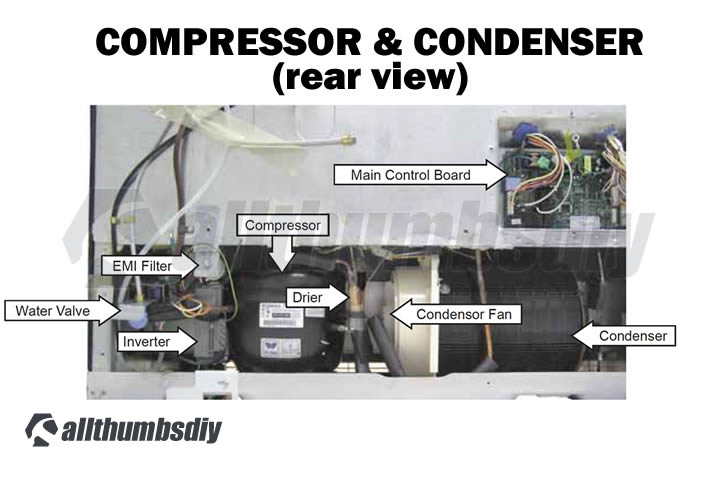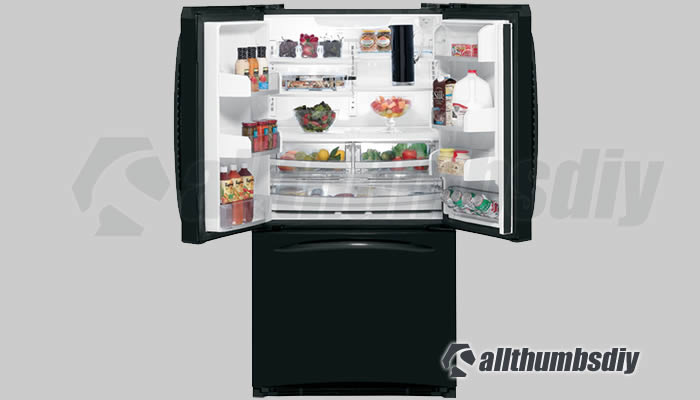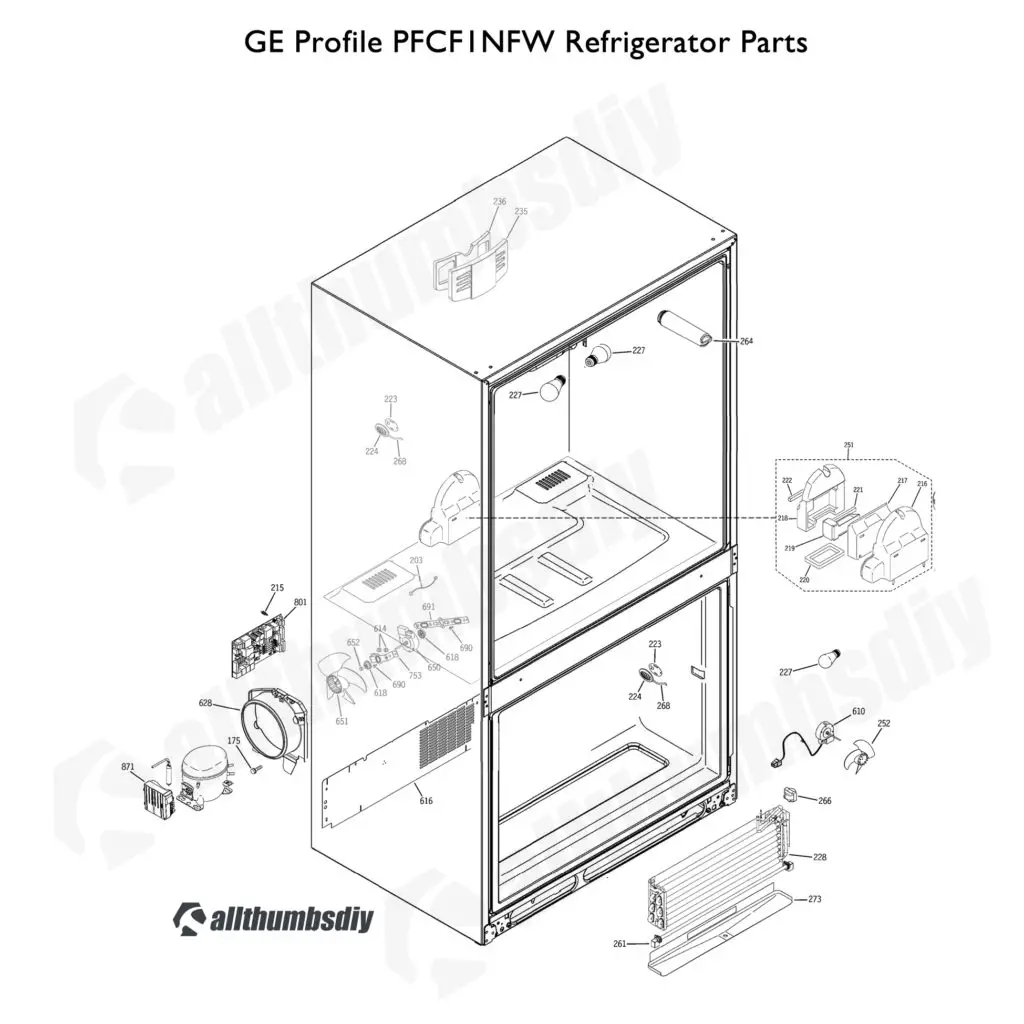Key Points
- It is very frustrating when a refrigerator starts to not work and you have no idea how to get it fixed
- Finding a competent appliance tech can be both difficult and expensive
- Learn how GE Profile PFCF1NFW is designed to work and triage your problems quickly and efficiently
Table of Contents
- Intro
- Primary / Serviceable Components
- Symptoms
- Component Failure Effects
- Required Tools
- Initial Troubleshooting Steps
- Triage – first step
- Triage – second step
- Symptom # 1 – both fresh food and freezer compartments are warm
- Symptom # 2 – freezer is working but fresh food (a.k.a. “fridge”) is warm
- Symptom # 3 – the entire refrigerator is not working or intermittently cooling
- Symptom # 4 – the refrigerator is NOT running at all
- Symptom # 5 – fresh food compartment is too cold (freezing fresh food)
| TIP |
|---|
| If you arrived at this page via a search engine, I highly recommend that you first read my Complete Reference Guide to GE Profile PFCF1NFW Refrigerator to get a good grasp on how GE refrigerators are supposed to work. |
Intro
In the course of 10+ years ow owning my GE Profile Refrigerator (model # PFCF1NFWABB), I had to make numerous repairs myself. Unlike my GE dishwasher (you can read about my trials here TBD), I really like my GE French-style refrigerator, even with warts and all.
Besides, I just the hate the idea of buying a new refrigerator at the first sign of trouble and throwing the old one in a landfill. We all have to do our part to minimize waste for our future generations!
Although I am NOT a trained appliance tech, I gathered enough valuable information along my journey so I am hopeful that this post will help you in your quest to solving your problems.
Primary / Serviceable Components
Below is a list of few primary and replaceable components that you may need when you are fixing your refrigerations.
For a complete list of parts, go to GE Profile PFCF1NFW Refrigerator Parts page.
| Diagram # | Part # | Description | Availability |
|---|---|---|---|
| 227 | 40A15 | Lamp | |
| 251 | WR17X12456 | Air Tower Assembly w/ Damper | |
| 252 | WR60X10208 | Evaporator Fan Blade | Check |
| 268 | WR55X10025 | Thermistor | Check |
| 261 | WR51X10094 | Defrost Heater Assembly | Check |
| 266 | WR50X10069 | Defrost Thermostat | Check |
| 610 | WR60X10185 | Evaporator Fan Motor, w/o thermistor/light | Check |
| 618 | WR02X11331 | Grommet, Evaporator Fan, Blue | |
| 650 | WR60X10209 | Motor, Condenser, Fan | Check |
| 651 | WR60X24484 | Fan Blade, Condenser Assembly | Check |
| 801 | WR55X10956 | Main Control Board | Check |
| 871 | WR55X10685 | Inverter ASM Board Kit With Jumpers | Check |
Common Failure Causes & Effects
- Condenser coil dirty – inefficient cooling process
- Condenser Fan Running Slow or Not Running at all – refrigerator “not cooling” or “intermittent cooling”
- Compressor not working – Fresh Food (fridge) and freezer may not work
- Inverter board not working properly – will cause compressor to not work (see above)
- Evaporator Fan not working – freezer may work; fridge will most likely not work
- Evaporator Ice Build Up – freezer may work; fridge may not; cooling will ultimately fail
- Defrost heater bulb not working – will cause evaporator ice build up (see above)
- Thermistor sensor(s) failure(s) – will report incorrect temperature data to the electronic control board; refrigerator may not operate correctly; thermistors will usually not fail completely but resistance reporting will not be accurate
- Electronic Control Board failure – if it is a partial failure, each function will need to be tested individually (i.e. J15 jumper to test for power output to the inverter board, etc.); complete failure is usually seen when both freezer and fridge lights are out
- Door switch failure – if the light switch fails, it may trick the refrigerater into thinking that the door is left open; in that case, a Liner Protection Mode may kick in which may result in the fresh food compartment being warm (Liner Protection Mode closes the damper to FF area)
Required Tools
- Flat head and Phillips Screwdrivers
- 3/8″ socket, socket wrench
- Multimeter (if you don’t own one, read my post “How to Buy a Multimeter“)
- Can of compressed air
- Vacuum
- Rags
- Pipe Cleaners
Initial Troubleshooting Steps
Check the door/light switch
check the door seals
run self diagnostics
test thermistors ; incorrectly performing thermistor would result in “too cold” or “too warm” complaints; also, (thermistors are DCV compient so a shorted thermistor would shut down the entire system
- STEP # A1 – Regardless of your refrigerator issues, you should first run the internal self-diagnostics to rule out simple issues
- If you don’t know how to run the test, you can learn it by reading my post “Troubleshooting GE PFCF1NFW Refrigerator Using the Temperature Display Control to Access Self-Diagnosis Mode”
Triage – Second Step
Step # A1 – Gently roll out your refrigerator to gain access to the rear panel;
Step # A2 – Using a 3/8″ socket, remove metal screws holding the cardboard panel
Step # A3 – You will find something like this (see below picture) behind the cardboard panel; please note that EMI filter is NOT part of the GE Profile PFCF1NFW model
Step # A4 – Observe the “pan” (underneath the compressor, condenser, drain hose); it may have some water (ok); if you see any black oily liquid, your closed system is most likely leaking and requires a trained technician
Step # A5 – Verify that the compressor is running by quickly swiping the compressor surface with the back of your hand; it will be warm to hot; you should also hear a humming sound with gentle vibration
Step # A6– Verify that the condenser fan is running (gentle humming sound); if the fan is not running, you need to replace the motor
Step # A7 – Verify that the condenser coil is clean; if caked on with dirt, you will need to clean it as best as you can using compressed air, condenser coil brush and vacuum. You should also remove the front toe-kick panel to clean from the front side; because the condenser coil is part of the closed system, you CANNOT remove it to clean so you will NOT be able to clean it completely

- Step #A8 – Choose one of the following conditions you are experiencing:
- a) Both Refrigerator and Freezer compartments are warm – Follow steps in Triage # B1
- b) Freezer is cold but Refrigerator is warm – Follow steps in Triage # C1
- c) Refrigerator is cold but Freezer is warm – Follow steps in Triage # D1
Symptoms
- Both fridge (FF) and freezer (FZ) compartments are warm
- Fridge is warm but the freezer is working
- Both compartments are warm with intermittent cooling
- refrigerator is not running at all
- fresh food is frozen
- compressor is extremely hot to touch
Symptom #1 – Both Refrigerator and Freezer Compartments are Warm
When both compartments are warm, you most likely will need to replace the logic board and/or inverter board.
In my case, I had to replace the inverter board twice (due to power failure/surge).
- Step # B1 – Look at the condenser fan to make sure that it is spinning quietly (i.e. gentle whirling sound)
- a) If the condenser fan is spinning, skip to Step # 6
- b) If the condenser fan is NOT spinning, use a multi-meter to test the fan power supply
- c) If the condenser fan is receiving power, the fan should be replaced; you should consider replacing the fan if you observe the fan blades wobbling or making clicking and/or screeching sounds
- d) If the condenser fan is NOT receiving power, you need to troubleshoot the fan power supply coming from the logic board (steps TBD)
- Step # 6 – Visually check to make sure that the condenser is clean (looking for lots of dust/hairballs attached to black coils); please note that the condenser is part of a sealed cooling unit so you need to make sure you do not damage it in any way.
- a) If the condenser is clean, skip to Step # 7
- b) If the condenser is dirty, use a soft brush or flexible pipe cleaner and vacuum to clean it; Once completed, go to Step # 7
- Step # 7 – Gently place your hand on the compressor (does not matter top or bottom) to detect gentle vibration/warmth
- a) If the compressor is gently vibrating and/or warm, it is working properly but your sealed system is not working properly.
- Unfortunately, if your sealed system may at fault; replacing a sealed system is not suited for a DIYer; you will be better off purchasing a new refrigerator as the replacement system costs over $450 and you will need to hire a technician with special tools to install it.
- b) If the compressor is silent and/or cold, you will need follow the steps outlined in my post “How To Fix a GE Profile Refrigerator that is not Cooling (Ugh, Again).
- a) If the compressor is gently vibrating and/or warm, it is working properly but your sealed system is not working properly.
Symptom #2 – Freezer is working but Refrigerator is Warm
This is one of the most common problems across many GE refrigerators (not just PFCF1NFW).
Most of the time, the usual culprit comes down to thermistors, defrost heater and/or defroster thermostat.
The problem with diagnosing thermistors is that they usually don’t go completely bad (i.e. does not result in the FAIL status during self-diagnostics) but the resistance parameters go wonky.
Some people experience this “freezer cold but the fridge is warm” problem intermittently which can be very expensive and time consuming (i.e. multiple calls to service technicians, replacing unnecessary parts, etc. all without solving the problem). I myself had this very exact problem which occurred every 3-4 days or so.
Although the ultimate solution may be simple but you will need to go through a series of troubleshooting steps, pause and observe an repeat.
- Step # 5 – Your refrigerator needs about 50-75% of capacity to be filled with food so that the each compartment temperature is properly maintained and your compressor is not working overtime.
- Visually confirm that you are not stuffing your fridge and freezer with food stuff
- If stuffed, create space around ventilation grills inside both the freezer and fresh food compartments
- If the temperature is not going down after 2-3 hours, proceed to next step
- Step # 6 – Verify that the condenser fan is running
- Step # 6 –
- a) If you should hear a loud “whooshing” fan noise blowing ice cold air, skip to Step # 6
- b) If you don’t hear the fan working, you will need to test for power at J2 jumper located on the main logic board
- c) If the evaporator fan is receiving power, you will need to replace the fan
- d) If the fan is not receiving power, re-test J2 jumper by reversing multi-meter test leads; if there is still no power, this main logic board needs to be replaced
The probable cause for this scenario is when the refrigerator and/or freezer compartment is storing too much. Having jammed packed refrigerator and/or freezer means limited air movement may warm pockets of air or cause ice build up on the evaporator.
- Step # 6 – Observe the evaporator by removing the freezer compartment trays and the rear cover (it should look something like the picture below)a) If the evaporator is covered in thick ice, you need to troubleshoot the defrost system (read this post TBD)
- b) If the evaporator has a minor ice build up (run your refrigerator at least 1 hour before observing), troubleshoot the damper assembly (read this post TBD)
- c) If the evaporator is clean (no ice build up whatsoever), it probably means your sealed system has failed. Please refer to the Triage # 1 – Step # 7a.
Symptom # 3 – The Entire Refrigerator Not Cooling or Intermittently Cooling
The “intermittent cooling” s one of the hardest problem to solve because it can be caused by so many components.
GE issues a service bulletin “REFRIGERATOR NO COOLING OR INTERMITTENT COOLING” back in May 2009. The service bulletin was intended for GE Models PFS22M and PFS22S (both French Door Bottom Mount) with serial numbers beginning with AM and DM.
The service bulletin stated that the possible causes included:
- Incorrect voltage to the condenser fan
- Overheating caused by poor air flow, causing sealed system restrictions and failure with compressors
To solve the problem, GE directed technicians to replace the main board (WR55X10656), compressor (WR87X10098) and evaporator (WR85X10057) under warranty.
Symptom # 4 – Refrigerator Is NOT running at all
- Open the refrigerator and confirm that lights turn on in the fresh food compartment. If not, replace the bulb and check again. If the light still does not come on, pull out the refrigerator to verify that it is not plugged into a GFCI outlet. If it is a GFCI outlet, check to make sure that it is on. Also check the breaker
- If you have lights, verify that the thermostat settings were set correctly (0 F for freezer, 36 F for Fresh Food)
- Note that the refrigerator turns on defrost cycle about once a day and lasts 30-45 minutes. During defrost cycle, the compressor and evaporator fan do not run so it may look like your refrigerator quit running. Check back in about an hour to see if the compressor and/or fan is running
- If there was a quick power outage (i.e. lights flickered or light went out and came back on very fast), the inverter board will cycle on and off until the refrigerant equalizes. At that point, the compressor will start and refrigeration will resume. If you have multiple, quick succession of power outage, your inverter board will probably break
- Check the control board to confirm that the fresh food compartment is not in DEMO mode (refer to my post “How to Enter Control
Fresh food (fridge) Compartment is Too Cold (freezing food)
Symptom # 5 – Fresh Food (Fridge) Compartment is tool cold (freezing fresh food)
If foods in the fresh food section are freezing, check the following things to see if it is something you can fix yourself or if your refrigerator requires service.
- Temperature Setting – Check the controls to make sure the refrigerator is set to the proper temperature. The proper fresh food temperature is between 37 and 42 degrees Fahrenheit. The freezer should be between 0 and 8 degrees Fahrenheit.
- Don’t stuff your refrigerator – Food load is an important factor. The drawers and compartment should ideally be 1/2 full or more. Freezing occurs when the refrigerator does not have enough food to absorb the cold air.
- Refrigerator compartments should be at least 1/2 full – If foods in the crisper, deli, and/or snack drawers are freezing, make sure the bins are at least 1/2 full. If the drawer has adjustable temperature and items are freezing, adjust the drawer to a lower setting.
- Don’t block the thermistors (temperature sensors) – if the refrigerator temperature sensor is blocked, it may not be able to correctly sense temperature to control cooling. The temperature sensor is located at the top left side of the refrigerator (covered by a “shark fin” dome). Move items so there is 6 inches of clearance around the sensor.
Replacing a Condenser Fan
Fix.com has a simple video showing you how to swap out the condenser fan motor (although the GE refrigerator model shown in the video is NOT PFCF1NFW, the layout is virtually identical)
Just a note that while you have the condenser motor and shroud off, CLEAN THE CONDENSER COIL INSIDE AND OUT with a brush/vacuum!
Key Takeaways
It can be very stressful and confusing to troubleshoot a non-working refrigerator, especially with many automated features like digital temperature maintenance and auto-defrost.
However, most problems can be solved if you triage the problem and each components.
Good luck with your project!




Tyler
Wednesday 27th of December 2023
Symptom # 4 - what if the fridge just stopped completely... no lights, etc.? Is it likely a control board failure?
kevin
Wednesday 27th of December 2023
If the refrigerator has absolutely no power, I would first unplug it for 10 minutes, then plug it into a known working outlet.
If that does not pan out, yes, I would consider replacing the control board first, then go from there.
Joyce Walsh
Friday 8th of September 2023
My fridge and freezer work fine. However, the lights inside a very dim or nonexistent. What would be the cause?
kevin
Tuesday 26th of September 2023
Hi Joyce,
Did you try replacing the bulb? Most bulb at the end of their life cycle behaves erratically.
John Furlong
Wednesday 13th of July 2022
Top half of refrigerator freezes milk and produce GE model PDS22SBNBS Any advise would be greatly appreciated